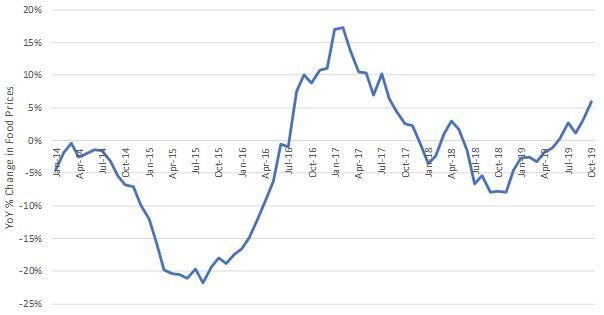Happy New Year!
In keeping with tradition, I thought I’d review a few highlights from last year, 2019.
2019 marked the first year in almost a decade when I didn’t have significant service responsibilities with the Agricultural and Applied Economics Association (AAEA). Nonetheless, time seemed to fill up with new responsibilities. Last year, I served on advisory boards or committees for organizations such as U.S. Department of Agriculture; Manna Partners; Council for Agricultural Science and Technology (CAST); National Pork Board; Noble Research Institute; and Veylinx, among others. I gave a large number of outreach presentations and talks, with the most noteworthy being testimony to the U.S. Senate Committee on Agriculture, Nutrition, and Forestry on issues facing the livestock and poultry sectors.
Last year was another productive research year. I’ll have authored or co-authored 20 peer-reviewed journal articles with a 2019 publication date, including articles in Economic Inquiry, Journal of Behavioral and Experimental Economics, Applied Economic Perspectives and Policy, and Food Policy, among others. Some highlights include a new review article on experimental auctions in the European Review of Agricultural Economics with Canavari, Drichoutis, and Nayga, a sole-authored piece in Journal of Economic Behavior and Organization on rationality, food choice, and income, and a paper exploring how people discount the future for decisions that involve their own outcomes vs. outcomes affecting others in the Journal of Risk and Uncertainty with Rong, Grijalva, and Shaw. I’ve got a couple grants and planned research on neuro-economics and consumer acceptance of gene editing (with Vincenzina Caputo and Marco Palma) and effects of changing cattle size and composition on consumer demand for beef (with Josh Maples, Glynn Tonsor, and Derrell Peel).
It’s also been a busy year in the Department of Agricultural Economics at Purdue. We were saddened at the untimely passing of one of our colleagues, Wally Tyner, and we celebrated the retirements of Otto Doering and Micheal Wetzstein. We were fortunate to hire two new endowed chair faculty members and begin searches for a couple new positions. The Department is celebrating it’s 100th year anniversary, and it’s been fun to reminisce about the past and strategically plan for the future (alumni, be on the lookout in the near future for a special issue of our annual print edition of Keeping Track).
Here on the website, there more than 106,000 pageviews in 2019, and there were 34 new posts. The number of page views is up significantly from the past couple years, but I fell below my goal of one post per week. Pressing administrative duties have eaten into time for blogging, but I’ll renew my goal for 2020 - about one post a week.
The most popular posts from last year were
Hope you have a great 2020!











